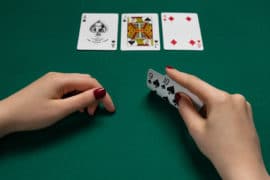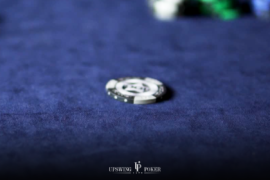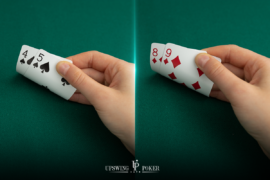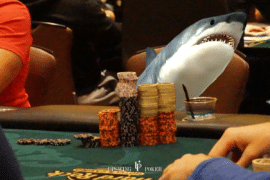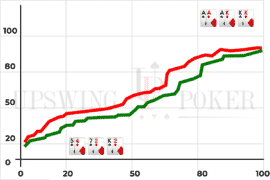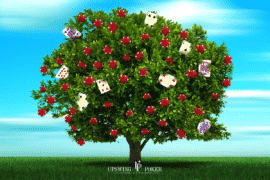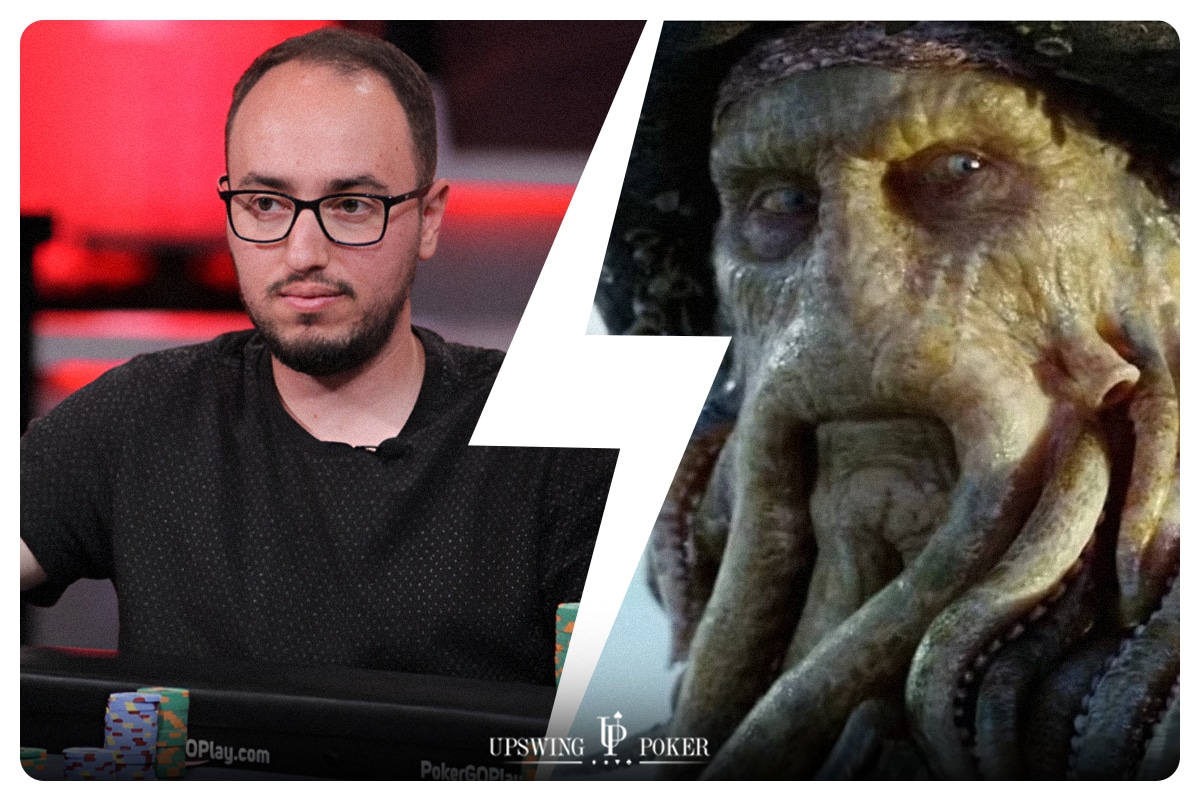
High-Stakes Showdown: DavyJones922 vs Barak Wisbrod in a $46,100 NLHE Pot
I’ve got some online nosebleed action to break down for you in this article. The main characters in this showdown are DavyJones922 (Roberto Perez) and iWasOnly17 (Barak Wisbrod), two players widely considered among the top 10 cash game crushers in the world.
The game is No Limit Hold’em, the blinds are $100/$200, and the stacks will be flying! Both players are around 100bb deep to start the hand.
Without further ado, let’s jump right in.
Preflop Action
Davy opens up the action with a raise of $500 from the Button with Ah Qs. Barak 3-bets from the Big Blind to $2,600 with Ad Td, and Davy calls.
Preflop Analysis
Davy should be open-raising around the top 40–45% of hands from the Button. A 2.5bb raise is optimal according to preflop simulations, as it puts most of Barak’s range in a tough spot. Ah Qs is a clear must-open.
Barak’s 3-bet range from the Big Blind should come in around 13%, including hands like 88+, A2s–A5s, A8s+, K8s+, Q8s+, J7s+, ATo+, KJo+, QJo, suited connectors, and suited one-gappers. He can’t 3-bet the weaker parts of that range at full frequency, but they’ll mix in at low to medium frequencies.
Ad Td is a hand that should 3-bet at a medium frequency.
The optimal 3-bet size from the Big Blind is typically between 11bb and 12.5bb ($2,200–$2,500). The goal is to dampen Barak’s positional disadvantage by creating a smaller stack-to-pot ratio (SPR).
Facing this larger 3-bet, Davy should defend with roughly 40% of his range. AQo is a hand that continues 100% of the time, mostly by calling, but also occasionally 4-betting at a low frequency.
Simple Analysis
Davy should always open-raise AQo from the Button—it’s a very strong hand and a clear part of his range. In general, he should be opening the top 40–45% of hands from this position.
Barak’s 3-bet range should be somewhat linear, coming in around 13–14%. Ad Td is a hand that mixes fairly evenly between calling and 3-betting.
Facing this 3-bet, Davy should always continue with AQo. The game theory optimal (GTO) approach is mostly to call, with some low-frequency 4-bets mixed in.
Flop Action
The flop comes Qd 9d 6s, bringing the pot to $5,297.
Barak (Ad Td) c-bets for $2,048. Davy (Ah Qs) responds with a raise to $5,406, and Barak makes the call.
Simple Analysis
With his nut flush draw, Barak has multiple viable options on the flop: betting big, betting small, or checking. In theory, all three lines are extremely close in expected value (EV).
When facing the small bet, Davy’s AQo becomes a marginal value hand. He should mix between raising and calling, with a slight preference toward calling.
Once raised, Barak should respond by calling. Given the strength of his draw, combining flush equity with two overcards, he has enough equity and showdown value to make calling the slightly better option.
Flop Analysis
On this type of flop, Barak holds both the range and nut advantage, as he’s the only player with hands like overpairs and top set. From a high-level perspective, this makes an aggressive c-betting strategy optimal.
That said, because the board is highly dynamic, his strongest hands prefer a large bet size, entering a two-street betting line where the plan is often to go all-in on the river. This helps deny equity to Davy’s drawing hands.
Another portion of Barak’s range is incentivized to use a small block-bet, aiming to extract thin value while hiding under the umbrella of stronger hands that will also occasionally use the small size. This strategy makes it difficult for Davy to raise frequently for value, given the looming threat of nutted hands. It thereby improves Barak’s equity realization with the middle of his range—hands like Qx, JJ, TT, 99, A9s, J9s, T9s, and so on.
Ultimately, multiple c-betting strategies are viable on this board. Barak could opt for a hybrid approach, splitting his range between large and small bets, or choose a one-size strategy, either consistently small or consistently large.
Without prior experience playing against Barak, it’s difficult to say which c-betting strategy he’s employing here.
That said, by using a 35–40% pot-sized bet, he’s signaling a more merged betting range. Against that kind of range, AQ becomes a marginal value raise—it can extract value from weaker top pairs, underpairs, second and third pairs, and draws. However, this shouldn’t be Davy’s default line. Raising too frequently in this spot would leave his calling range overly weak and vulnerable to exploitation on later streets.
From a range construction standpoint, Davy should only be raising with strong but vulnerable hands like AQ, KQ, and Q9s (at low frequency), as well as bottom set, which unblocks much of Barak’s bet-calling range. Meanwhile, he should call with his stronger value hands like QQ and 99.
As for bluffs, the raising range should include nut flush draws, combo draws, weak offsuit hands with double backdoor flush draws (e.g., Ax Td and Ad Tx), and some small to medium pocket pairs with a backdoor flush draw—all at low to very low frequencies.
Facing this raise, Barak should mostly call with Ad Td. His Ace and Ten both have the potential to make top pair, giving the hand reasonable equity. A hand like Ad 5d, by contrast, is a better candidate to raise as a semi-bluff, since its pair outs are far less likely to be good at showdown.
Turn Action
The turn brings the 2c, making the board (Qd 9d 6s) 2c. The pot is now $16,109.
Barak (Ad Td) checks. Davy (Ah Qs) fires for $4,832, and Barak makes the call.
Simple Analysis
Barak should always check in this spot, he has a significant range and nut disadvantage.
Davy, on the other hand, should always barrel with AQ. It’s a very strong hand here, especially since Barak would likely have 3-bet all-in on the flop with overpairs and even some of his own AQ combos. The optimal turn sizing is around 50% pot. By betting smaller, Davy allows Barak’s draws to realize their equity more easily, without extracting maximum value or applying pressure.
Facing this small bet, Barak should either check-call or check-raise. With such a high-equity hand, continuing is mandatory, regardless of which line he chooses.
Turn Analysis
The 2c turn is one of the best possible cards for Davy’s range. None of Barak’s draws improve, and he would have raised most of his overpairs on the flop, so donk betting is off the table as part of an optimal strategy here.
As a result, Davy now holds a very strong hand and should be value-betting. With so many value hands in his range, he’s also incentivized to continue barreling his bluffs at a high frequency. Given his nut advantage in this spot, the preferred strategy is to use a larger size, around 50% pot.
This is where Davy makes a small mistake. By using a smaller sizing, he increases Barak’s EV, giving him a cheaper price to realize his equity with drawing hands.
Against this small bet, Barak should fast-play many of his top pairs due to the shallow SPR, aiming to get the money in now before Davy’s bluffs give up on the river. He should also check-call or check-raise with all of his strong draws (flush draws, open-enders, and combo draws) as they have high equity, strong implied odds, and are getting a good price.
With Ad Td, Barak should likely shove at this point, unless he believes Davy is underbluffing. If that’s the case, he may not have enough fold equity to justify the raise and would be better off just calling.
River Action
The river comes the 2d, making the board (Qd 9d 6s 2c) 2d. The pot is $25,774.
Barak (Ad Td) checks. Davy (Ah Qs) shoves $10,164. Barak calls.
Simple Analysis
Barak should always check here, his range is extremely weak. If you’re reading this and still learning the ropes, I’d strongly advise avoiding donk bets altogether. There are very few spots where they’re theoretically correct, and even then, they’re difficult to execute well and offer minimal EV gain.
Davy faces a tricky decision with AQ. On one hand, he’s highly likely to have the best hand. On the other hand, the value of a shove is heavily dependent on how often Barak arrives at the river with flushes. If Barak tends to check-raise his flush draws aggressively on the turn, then shoving becomes the best play. If he leans more passive and check-calls them, then checking back is likely the better option.
It also comes down to how willing Barak is to make hero folds. If he’s the type to fold hands like QJs or QTs in this spot, then jamming AQ is simply too thin, and checking back is clearly best.
River Analysis
The river 2d is an above-average card for Davy, as many of his missed flush draws have now improved.
Barak, meanwhile, is at a severe range and nut disadvantage. He should have raised a large portion of his flush draws on the turn, meaning he arrives at this river with very few flushes, while Davy retains most of his. As a result, donk-betting is off the table.
From a theoretical standpoint, Davy should continue barreling with AQ. It’s a thin value bet, but one that makes sense given the structural advantage of his range. That said, the decision is heavily dependent on Barak’s tendencies. If Barak tends to realize equity passively by check-calling flush draws on the turn, then jamming AQ here would likely be a mistake. But if he plays closer to a solver-influenced strategy, where he frequently check-shoves his strong draws on the turn, then AQ becomes a clear candidate to barrel for value.
Another key factor is how call-happy Barak is on the river. If he perceives Davy’s range to be too strong in this spot, which is easy to do, given that Davy’s only natural bluffs are hands like 55, 44, 33 with a diamond, or ATo with a diamond, then Barak might overfold. If he’s folding hands like QJ or QT, then Davy’s shove becomes far too thin, and checking back would be the better play.
This is where knowing your opponent really matters. A strong theoretical foundation, combined with experience and sharp focus, is what enables players to navigate these close spots correctly.
As for Barak, his river decision is about as easy as they come: calling is mandatory, and there’s no way to go wrong there.
Final Thoughts
While there’s always more that could be said about the intricacies of this hand, it serves as a great example of where the highest levels of poker are today. It’s all in the nuances. At this level, players rarely make pure EV mistakes—the game revolves around the preferences they express within the game theory-optimal boundaries of each situation.
Reaching this point requires an exceptional level of technical skill: recognizing threshold moments across streets, understanding the mechanics that create them, studying opponents’ tendencies off the felt, and maintaining sharp focus in the heat of battle. These players are true mental athletes operating at the highest caliber.
That’s all for this breakdown! I hope you enjoyed it and learned something new—I had a blast writing it. As always, feel free to leave a comment or ask a question below.
Til next time, good luck out there, grinders!
If you’d like to read about more big pots between great players, read: Epic Showdown at the Cash Game World Championship (Linus vs. PR0DIGY).

